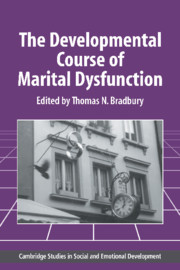Book contents
- Frontmatter
- Contents
- List of Contributors
- Foreword
- Introduction: The Developmental Course of Marital Dysfunction
- Part I Conceptual and Empirical Contributions
- 1 Communication in Early Marriage: Responses to Conflict, Nonverbal Accuracy, and Conversational Patterns
- 2 Marital Aggression, Quality, and Stability in the First Year of Marriage: Findings from the Buffalo Newlywed Study
- 3 Accommodation Processes During the Early Years of Marriage
- 4 The Psychological Infrastructure of Courtship and Marriage: The Role of Personality and Compatibility in Romantic Relationships
- 5 Happiness in Stable Marriages: The Early Years
- 6 Developmental Changes in Marital Satisfaction: A 6-Year Prospective Longitudinal Study of Newlywed Couples
- 7 The Development of Marriage: A 9-Year Perspective
- 8 Premarital Predictors of Relationship Outcomes: A 15-Year Follow-up of the Boston Couples Study
- 9 Optimizing Longitudinal Research for Understanding and Preventing Marital Dysfunction
- 10 Socialization into Marital Roles: Testing a Contextual, Developmental Model of Marital Functioning
- 11 Physical Aggression in Marriage: A Developmental Analysis
- Part II Invited Commentaries
- Author Index
- Subject Index
3 - Accommodation Processes During the Early Years of Marriage
Published online by Cambridge University Press: 13 October 2009
- Frontmatter
- Contents
- List of Contributors
- Foreword
- Introduction: The Developmental Course of Marital Dysfunction
- Part I Conceptual and Empirical Contributions
- 1 Communication in Early Marriage: Responses to Conflict, Nonverbal Accuracy, and Conversational Patterns
- 2 Marital Aggression, Quality, and Stability in the First Year of Marriage: Findings from the Buffalo Newlywed Study
- 3 Accommodation Processes During the Early Years of Marriage
- 4 The Psychological Infrastructure of Courtship and Marriage: The Role of Personality and Compatibility in Romantic Relationships
- 5 Happiness in Stable Marriages: The Early Years
- 6 Developmental Changes in Marital Satisfaction: A 6-Year Prospective Longitudinal Study of Newlywed Couples
- 7 The Development of Marriage: A 9-Year Perspective
- 8 Premarital Predictors of Relationship Outcomes: A 15-Year Follow-up of the Boston Couples Study
- 9 Optimizing Longitudinal Research for Understanding and Preventing Marital Dysfunction
- 10 Socialization into Marital Roles: Testing a Contextual, Developmental Model of Marital Functioning
- 11 Physical Aggression in Marriage: A Developmental Analysis
- Part II Invited Commentaries
- Author Index
- Subject Index
Summary
Sometimes married life is blissful – intimacy and companionship are easy, feelings of trust and commitment are strong, partners treat one another with love and consideration, and the marriage seems indestructible. Unfortunately, many couples encounter periods when life is not so easy – times when intimacy and companionship are hard work at best, good times are a distant memory, trust and commitment are sorely strained, and the marriage verges on collapse. Much of married life unfolds in a middle ground between these extremes, in a state where good times are punctuated by dissatisfying incidents of greater or lesser intensity. The manner in which couples negotiate this intermediate state appears to be crucial to maintaining a long-term, enduring marriage. This chapter deals with one important feature of the “middle ground” of marriage by analyzing an interaction phenomenon termed accommodation. Interaction sequences involving accommodative behavior are initiated when one partner engages in a potentially destructive act, such as behaving in a thoughtless manner, saying hurtful things, yelling at the partner, or worse. Accommodation refers to an individual's willingness, when the partner has enacted a potentially destructive behavior, to (a) inhibit impulses to react destructively in turn and (b) instead behave in a constructive manner.
- Type
- Chapter
- Information
- The Developmental Course of Marital Dysfunction , pp. 74 - 113Publisher: Cambridge University PressPrint publication year: 1998
- 93
- Cited by



